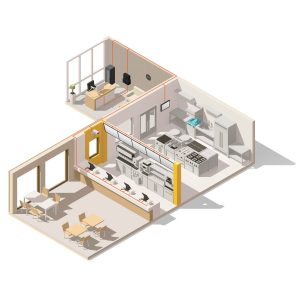— By David Sansenbach —
Efficient energy management requires high-quality power, not just high-quality equipment.
For businesses in an industry that operates on tight margins, restaurants have incredibly intensive energy demands that continuously increase costs and challenge the bottom line. Estimates from the last decade show restaurant spaces require an average of 38 kilowatt-hours (kWh) of power per square foot of space, with quick-serve restaurants in particular surging to even steeper costs of 81 kWh per square foot. A fair share of this energy is consumed by critical electronic infrastructures such as sensitive POS systems. Given the power consumption of this equipment, efficiently managing the energy it uses should be a key concern for franchisees and facility managers.
Focus on Power, Not Just Power Usage

David Sansenbach, AMETEK Powervar
In pursuit of more cost-effective restaurant operation, the focus has typically been directed towards improving the energy efficiency of the facility’s equipment, both from building owners and operators as well as from regulators. This approach is perfectly logical, as modern equipment is far more energy-efficient than previous generations of technology, and future versions will be even more efficient still. It is in the interest of all stakeholders to outfit their spaces with the most energy-efficient equipment available, whether a franchisee wants to lower operating costs or regulators want to reduce the burden on the public grid. That said, what decision-makers should be prioritizing is not necessarily the energy efficiency of equipment, but rather the most efficient management of their energy consumption in general.
When equipment is factory tested to determine expectations for energy efficiency, lifecycle and required maintenance frequency, it is done so under clean power conditions. Once sold and installed into a commercial kitchen or restaurant space, the equipment departs from those clean power conditions and instead must rely on power from the grid. Grid power is quickly compromised once inside a commercial space where it is subjected to the ever-present electrical noise emitted by each piece of electrical equipment in the vicinity, especially energy-intensive machinery like commercial refrigerators. Electric cooking equipment, HVAC systems and even overhead lights also emit noise in the form of electrical impulses, high-frequency noise and high-voltage transients. Over time, these minor, manifold blips corrupt the smooth sine wave electrical power is supposed to travel along. These anomalies result in subsequent departures from the expected performance baselines the manufacturer originally assigned to its equipment.
Power Quality Impacts Performance Across All Time Horizons
Dirty power won’t necessarily destroy equipment, just as low-octane gasoline won’t crash your car. The issues it causes come in the form of degradation, system lockup and undetected data logic errors, which all contribute to the slow erosion of system components and performance levels. For example, consider that POS systems are expected to last 5 to 7 years under normal operation. If they are consistently served high-quality power, they are much more likely to hit the high end of that estimation than if they run on “dirty” power that is left untreated. Amortizing expensive equipment across those two additional years is the difference between assigning 20% annually and just over 14% a year, independent of interest. That’s a big margin in a small-margin industry and serves as a proof point that long term efficient energy management is about much more than individual products’ energy efficiency.
 Dirty power can also impact performance in shorter time horizons. For instance, an untreated power spike that knocks down a POS system for an hour could compromise dozens of transactions and ruin the customer experience for many guests. In addition to the immediate loss of revenue, many of these customers may never return. This is especially true in the quick-serve restaurant industry where speed is the core priority. In 2021 the average drive-thru time was 6 minutes and 22 seconds, according to research from SeeLevel HX. If a downed POS system doubles that time, customers will leave with a bad taste in their mouths, regardless of how tasty the food is.
Dirty power can also impact performance in shorter time horizons. For instance, an untreated power spike that knocks down a POS system for an hour could compromise dozens of transactions and ruin the customer experience for many guests. In addition to the immediate loss of revenue, many of these customers may never return. This is especially true in the quick-serve restaurant industry where speed is the core priority. In 2021 the average drive-thru time was 6 minutes and 22 seconds, according to research from SeeLevel HX. If a downed POS system doubles that time, customers will leave with a bad taste in their mouths, regardless of how tasty the food is.
POS system issues can arise even when equipment remains online, as electrical noise from refrigerators or other machinery can interfere with data transfer and lead to logic and communication issues from order terminals to site controllers to ticket printers. That could result in incorrect or lost orders. However, when fed properly protected power, POS data strings are sent and received without error, so no lock ups or order detail issues occur.
Fortunately, Solutions Exist
With the knowledge that inferior power quality can adversely impact equipment lifespan and day-to-day performance, comes the fiscal responsibility of implementing proper solutions to ensure high-quality power. The three key components that ensure a solid power quality system are a surge diverter, a noise filter and a low impedance isolation transformer. As the name implies, surge diverters — also called surge protectors — are designed to divert surges, or high voltage transient or impulses, away from the sensitive electronic systems they protect. However, this does not eliminate the impulse, which means the power problem persists and the system strains. That’s why the other two components are necessary, particularly the low-impedence isolation transformer. This feature acts to isolate the powered instrument from the power source and re-establish the neutral-ground bond. It does this without opposing or disrupting the current path, keeping unwanted noise out without negatively affecting power flow. This process ensures only clean, reliable power consistently flows to and through equipment. Solutions without a low impedance isolation transformer may actually cause disturbances — and therefore downtime — rather than reducing them.
But what if the power goes out entirely? Nearly every restaurant has a generator ready to go in case of abrupt blackouts that temporarily down the grid, but these products can take 30 seconds (or more) to get going. That 30-second delay represents a ~10% to 15% increase in a customer’s average drive-thru transaction time. Deploying a local area UPS system bridges this power gap because it is always active, providing power conditioning even when not providing the power itself. Some even feature hot-swappable batteries to allow the unit to stay online during maintenance. Though skeptics may question how much power these solutions themselves consume, leading solutions deliver what’s called a unity power factor, where >99.9% of the power that goes into the power conditioner comes out of it and is sent along to equipment. Working in concert, each of these features ensure that a restaurant is never unable to meet customer expectations due to power problems.
Conclusion
Efficient energy management is critical to maintaining a competitive advantage in on-prem restaurant service, which due to the proliferation of delivery dining and ghost kitchens have been thrown into stark relief in the last 2 years. This task is far broader than simply optimizing the energy efficiency of equipment. The simple truth of the matter is that if a restaurant is looking to optimize energy efficiency, restaurant facility managers and franchisees need to not only think about how much energy it takes to run the business but also how much business untreated energy can take away.
— David Sansenbach is national account manager, retail technologies, of AMETEK Powervar, which specializes in providing power quality solutions to the POS industry. For more information, visit www.powervar.com.

